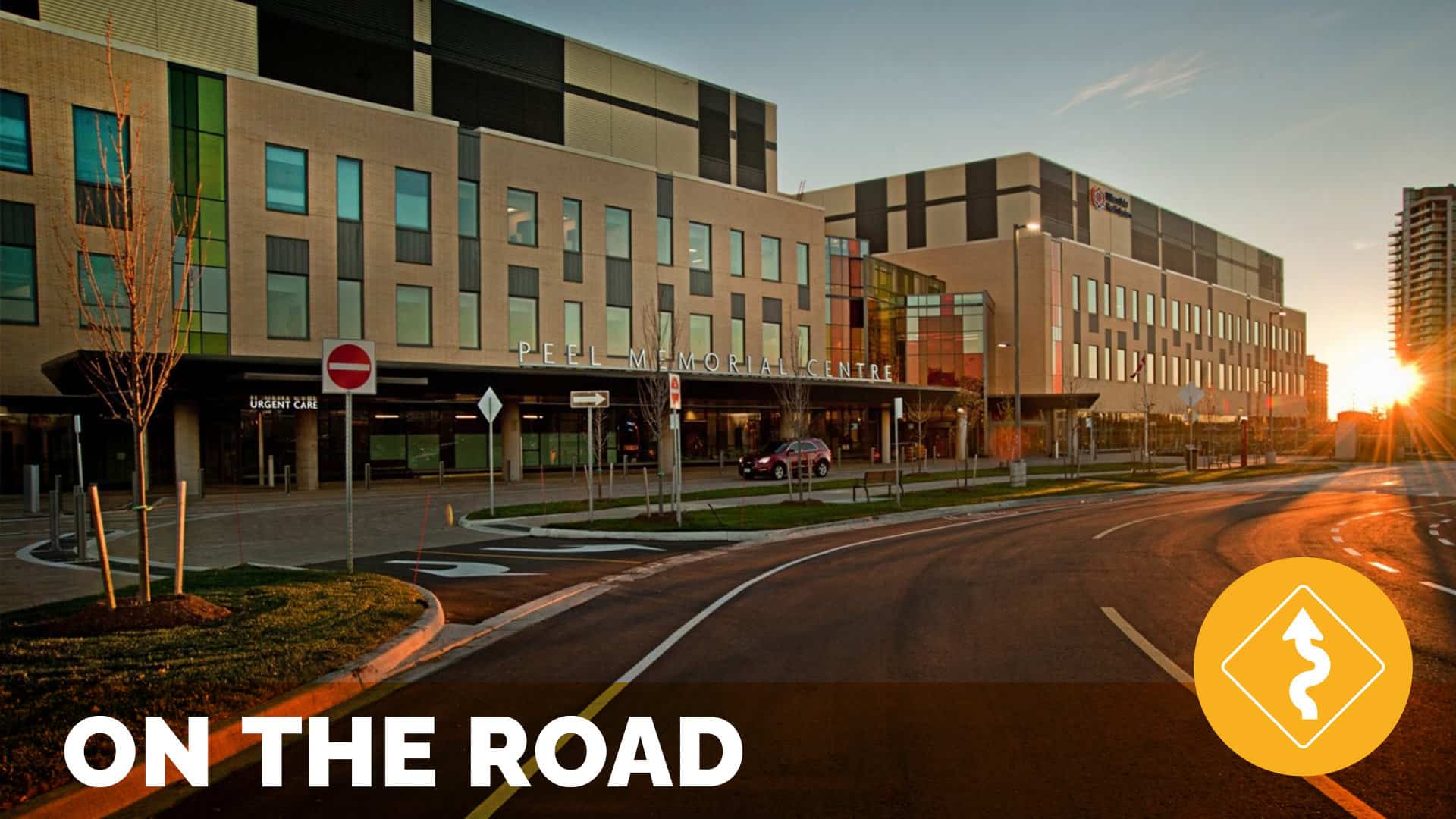An Unwavering Commitment to Patient-Inspired Care without Boundaries

On the Road with William Osler Health System – July 2013
by Jason A. Wolf
Patient-Inspired Care
Continuing the global dialog on patient experience improvement I was honored to be invited to William Osler Health System (Osler) in Brampton, Ontario, Canada to speak at the community kick off of their new strategic plan. I also took advantage of the day to join them for an On the Road visit as well. While I will say more about the plan and the event later, I would be remiss if I did not mention the powerful statement Osler made in their strategic plan, which has as its very first strategic direction, “Create health services with an unwavering commitment to patient-inspired care.” While that is a powerful statement in itself, what was more moving to me was the vision that framed that direction patient-inspired care without boundaries.
There are not many opportunities I have to experience a health system that sets the stage for its strategy with experience first. More so, in this powerful statement is something profound. Osler’s CEO Matt Anderson noted in introducing the plan (and reinforced in his recent blog), that at Osler, they are creating ways to not only connect with patients and their families, “but to listen, learn and act in real-time to provide patient-inspired care for our community.” The powerful statement is that of patient-inspired. This is not just informed or considered, but rather the driving cause for the system in moving its strategy forward.
It also makes a bold statement that, as the introductory video shared at the kick-off event reinforces, “a new day is dawning” and there is a boundless commitment to their effort. To not be limited by standard convention or deterred by different ideas, but rather to embrace all opportunities presented and tackle the effort with a broad and open perspective. This commitment was exemplified by my incredible visit with the Osler system’s two main hospitals – Brampton Civic Hospital and Etobicoke General Hospital. A third hospital, the Peel Memorial Centre for Integrated Health and Wellness, is currently under redevelopment and on track for completion in 2015-2016.
The highlights from my visit, I also mention briefly in my remarks delivered at the kick-off event. My hope here is to share the implications for practice they offer and the visible impact they have. The headlines of what I experienced are exemplified by four stops on my journey: my observations of the work in both facilities Emergency Departments (ED), the uniquely designed in-house call center that drives patient experience data immediately back to units for rapid response, the family focus guiding women’s and children’s services, and the power of recognition, respect and environment exemplified by a recent oncology renovation. My hope is that in sharing these simple, yet significant ideas, you too may be inspired to reach beyond your boundaries in providing excellence in patient experience.
Help Us FIND Our Way
I started my visit at Etobicoke General, and as so many patients and family members do in many hospitals, entered the facility via the Emergency Department doors. The ED, while in an older facility, was working on a new “attitude.” In speaking with Erica Coobs, Patient Care Manager, Emergency Services at Etobicoke General, she spoke of the systemic nature of an ED redesign not in environment, in as much as people, process and even technology.
While working to maintain the required ED standards in a Canadian system, you can sense the strong similarities of ED challenges globally. As a primary entry point for people to so many care situations, from simple issues to much more emergent scenarios, the ED very often feels as if it is bursting at the seams. Erica talked about the fact there is critical need not only to create more efficient processes to engage patients and family during their visit to the ED, something both Osler hospitals seemed to be working hard to achieve, but also to educate the public on the best use of ED services. She noted it was an educational opportunity that truly must be focused on a community, versus simply a facility solution.
With this, she and her colleagues at Brampton Civic have worked hard to create efficient ED processes. Whether the older quarters at Etobicoke General or the new and extensive ED at Brampton Civic, the recognition of a few critical components seemed very consistent with Oslers mission to go beyond. From processes to more efficiently identify the nature of a patients need and route them quickly and responsibly, to the actual signage that can help alleviate concerns and simplify processes for a patient or family member in a time of potential stress, distraction and distress.
In the emergency areas at both hospital sites, the process for patients begins right at arrival with signage guiding people to admissions and triage. Then following the Canadian Triage & Acuity Scale (CTAS, which I wrote about during my earlier visit to British Columbia) patients are effectively routed to various areas of the ED. From rapid response units to more emergent situations, colored markings on the floor literally guide people from the ED entry to their specific intended location. This includes a now standard Medical Assessment Unit (MAU) that enables patients with slightly more significant situations requiring monitoring, but not necessary admissions, to stay for 24 hours or sometimes longer as they are assessed and cared for.
Now while signage and processes are key, and an important element of working with and educating the community adds rigor to a broader ED strategy, in asking Erica about the keys to her success, she added, “With all of this, it is still about our people, our team, and our focus.” Noting that it was the commitment of staff to the strategy that ultimately guided their efforts and outcomes. I could sense this in my encounters with many of the physicians, nurses and aides that I had the chance to meet on the tours. It truly was an incredible team effort, moving massive numbers of people on a path, or better stated perhaps a busy highway, to health.
One of the last items I noticed on my ED visits were individuals moving through the ED with tablets talking to patients. I came to learn these were actually members of the Osler team collecting real time data on the experience “iPaders” as they are affectionately named. Their purpose is to collect the story of what is happening in the ED at all times, by inquiring about the experience overall, the treatment by staff, the perception of the wait, etc. This data is gathered daily and provides an in the moment pulse of the ED experience. I came to learn this was part of a broader effort to capture and act on the patient and family voice.
Hear our Voice AND Act
While the “iPaders” wowed me with a simple, yet powerful process for collecting data that could be used immediately for improvement, what I soon came to learn about was Osler’s extensive effort to collect experience date for immediate learning and process improvement. More than just a survey solution to create scorecards, the team at Osler, led by Walter Rojenko, Executive Director, Service Excellence have created a true feedback and performance improvement system; one with a minimal footprint, a creative staffing model and significant impact.
The call center initiative is designed around one idea, that in capturing the voice of patients and families directly and immediately after their visit, you can not only identify opportunities for improvement, but also determine where activity is occurring to improve patient experience, detect units or departments making progress or struggling, and create avenues for rapid response and improvement based on immediate feedback. A small team of 4 to 6 people currently staffs the call center. It actually only has one full-time employee. The remaining members of the team are modified workers from the Osler system who due to specific medical situations are pulled from their direct duties, but still have the capacity to work and are already on payroll with the system. These are nurses and other front line workers from the system who are trained fully on the process and then immediately put to work.
The process itself is simple as well. Within 48 hours of discharge, patients receive a call from Osler inquiring about the nature of their visit. A standard 10-question script is followed and the data is recorded electronically in a database. Responses are associated with the primary unit a patient experienced during their stay and are related to experience of care, not designed for clinical follow-up, information on medications, etc. It is purely to gauge the perspective of the care experience.
The power of the data was immediately clear as well. From the very call center “floor,” which actually comprised a small office of 6 cubes and a desk, 46,000 calls were made last year alone. Once the data is captured, they are ready to be pulled for unit review and action planning. In fact reports for all units are publically available on the Osler intranet so people can view their reports, and those of others as well. This transparency of data reinforces the going beyond mission, by stressing the important of hearing and acting on patient voice. As Walter shared so poignantly about the power of not only the data, but its eventual use, “it is one simple gesture that separates excellence from satisfaction.”
In fact, the process requires the review of this data in real time in unit huddles at least a few times weekly and teams can then address situations immediately based on the feedback received. I have heard many challenge the usefulness of survey data in the United States, due to required processes and the delayed reporting. Perhaps there is something to learn from this highly efficient, streamlined and active model for hearing and acting on patient input for immediate improvement. This feedback also helps patients, families and the community know they are listened to and that the Osler team truly cares. This idea helps frame two other brief encounters I had that were powerful examples of my overall Osler experience. This first, is showing that you care.
Show us you really CARE
I was impressed on my visit through many of the units to experience their caring attitude and commitment to patients. A great example of this was in the Women and Children’s area at Brampton Civic. While in full disclosure, this may have stood out now being a new father and recently having my own inpatient experience with the arrival of our son, the efforts exemplified something more broadly I sensed about Osler, showing people they truly care.
In this area, I was impressed in particular, by the extensive support network built around the birth of a child and especially that of the neonatal intensive care unit (NICU). The team in the NICU has an incredibly challenging, fragile and truly precious task to take care of newborns in need. Yet while this is their primary service, the recognition of family in these potentially challenging situations was evident. Brampton’s unit provided practices that stood out as part of their continued effort to go beyond. The first, was a provision for a family room where family members can stay overnight, freshen up, etc. in these specifically emergent situations where their presence is desired or needed. This simple offering makes a big statement that as family you are welcome here, not in the way of care.
A second touch was that of family transition rooms. I was impressed to see an actual room with all the medical needs managed for baby, but there was also a small kitchenette and a double bed for babys parents. Yes, I said double bed the first time I ever saw that in a hospital. Patients provided feedback that pull out couches or other hospital couch-bed combinations made the stay uncomfortable, so the unit pushed for and was able to create transition rooms that felt a little more like home. In caring for the whole family in transition, another potential for excellent experience is created. These examples again show the powerful simplicity of creating true experience. It leads me to my last observation, about how as patients we want to be treated for who we are.
Treat us for the people we ARE
On the last leg of my tour before the kick off event the evening of my visit, I had the chance to tour the oncology unit at Brampton Civic. What I experienced was a transformational place, far beyond your typical clinical setting seen so often by cancer patients and family. For this segment of my tour, I was accompanied by Sonia Lovat-Scarcello, whose family contributed to the redesign of this place of fighting, healing and recovery.
Inspired by the experience of her own mother, Sonia and her family worked with Osler and the community to provide for a great space for healing. From easier check in procedures for patients arriving for treatment, to a lobby/waiting area as comfortable and welcoming as any I have ever seen in healthcare, to treatment bays and individual rooms that respected both the desires for privacy or community, but also worked to reinforce healing versus illness.
Of note here was this was not simply an Osler initiative, it exemplified its strong community connection, sense of community responsibility and commitment to the perspective of who patients are, not simply their diagnosis. Patients are provided a full guidebook on arrival and even a small gift of a healing stone as a symbol of and support for their healing journey.
OncologyI share this not to talk simply about nice facilities, but rather about broader intention. Creating the best in experience is about all the senses, it is about all that is logical and illogical about a clinical situation, it is about the emotions patients and families bring to the journey. The oncology unit at Brampton, in a subtle, yet profound way struck at the very essence of patient-inspired care, of what experience can and should be. It is about the dignity and respect provided, the clinical expertise and healing delivered; it is about care, voice, and direction as exemplified on my journey through the Osler system.
Going Beyond and never relenting!
These are snapshots of a day filled with incredible sights and sounds, the openness of staff at all levels to share the raw and exciting opportunities they had ahead, a great staff lunch where senior staff served the entire facility staff and ultimately a kick off of a new strategic plan for the future of Osler’s experience and healing efforts.
They are also a culmination, or rather I should say a milestone, along a continuous journey of experience improvement punctuated by such thoughtful and powerful events as the Osler Patient Experience Summit in which community members were gathered to provide input on how to continue to offer and improve upon an excellence experience.
My visit wrapped up with the powerful community kick-off of the new strategic plan and the opportunity again to reflect on my visit. Sitting in a tent, constructed in the parking lot outside Brampton Civic, I sat and listened to the voices of senior leadership, the board, community members and the rest talk about the importance of all that has been achieved and more so of that yet to be done. As I shared in my talk, I saw a quote posted on the wall of a rehab unit that exemplified to me an important perspective on patient experience improvement overall, “you accomplish victory step by step, not leaps and bounds.” It is truly about an intentional and focused effort, but what Osler has done (and that many have yet to do) is codify its ideas and its commitment in its strategy itself. More than leaders declaring it, or signage espousing it, this is perhaps the biggest, boldest and most significant statement of commitment to experience I have seen.
So as we learn from the Osler journey or from the many other On the Road stories or case studies, papers or webinars The Beryl Institute publishes; as we learn from one another in a community of peers committed to contributing to shared improvement, we know there is still great work to do. The team at Osler acknowledges this by having a plan about creating patient-inspired care without boundaries, with no boundaries, there is no place ultimately to stop. As I closed my talk, I share the same thought to challenge the entire patient experience community. Guided by the words of Osler’s plan, continue “going beyond,” great things are waiting just over the horizon and the patient experience journey truly does not and must not end.
Related content
-
 Patient Family & Community Engagement
Patient Family & Community EngagementA Qualitative Study Patients Expectations of Private Hospitals
Objectives: This study was conducted to explore patients’ expectations and perceptions of private healthcare facilities, understand the key factors influencing their choice of such facilities, also identify elements that enhance patient satisfaction and loyalty, enabling the development of actionable recommendations to improve patient-centered care in private healthcare settings. Method: A qualitative study using thematic analysis
Learn more -
 Patient Family & Community Engagement
Patient Family & Community EngagementPX Chat on PFA/PFACS: Revitalizing/Rebuilding (April 9, 2025)
12pm ET / 11am CT / 10am MT / 9am PT – Join The Beryl Institute community for an opportunity to connect with your peers on the support and resources needed to address efforts around revitalizing and rebuilding PFAs and PFACs in their organizations. Breakout discussion groups allow you to share your challenges, celebrate your
Learn more -
 Culture & Leadership | Patient Family & Community Engagement
Culture & Leadership | Patient Family & Community EngagementNational Human Experience Movement Led by SOBREXP in Brazil
Global Headliner Webinar Series (Complimentary) – Join this webinar to discover the inspiring journey of Brazil’s National Movement in Human Experience, led by SOBREXP, the Brazilian Society of Patient Experience and Person Centered Care. Learn about the timeline, strategies, challenges, and key achievements that have shaped this groundbreaking effort to elevate the human experience. Tuesday,
Learn more
